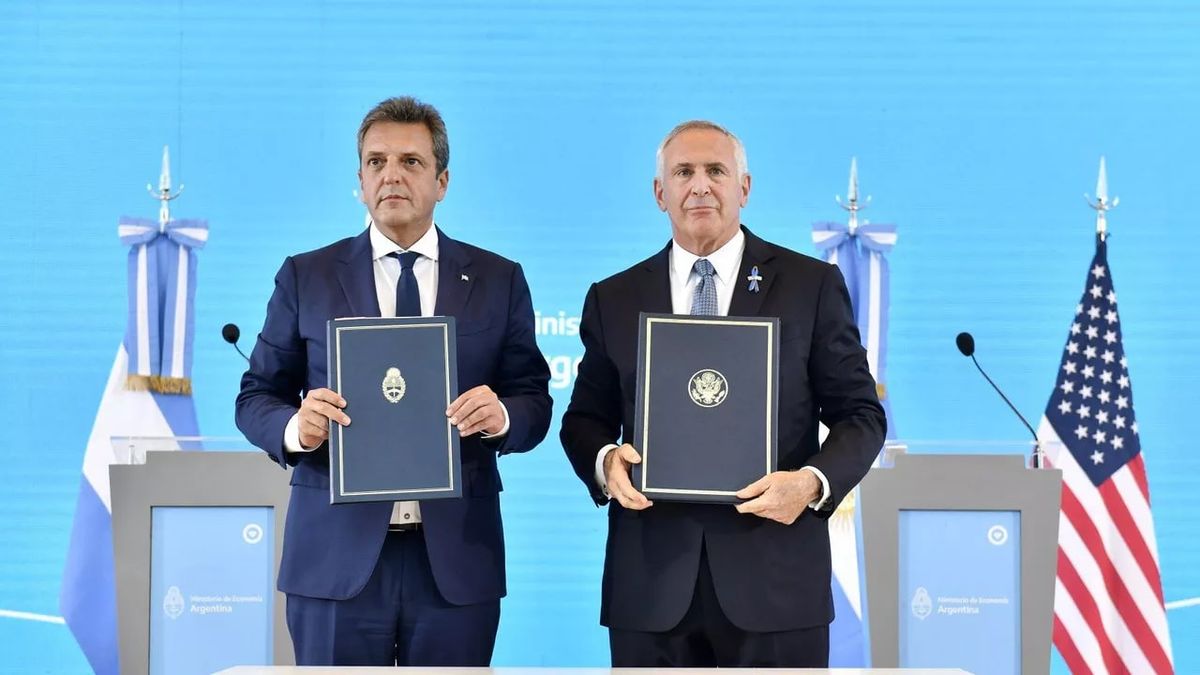massa stanley acuedo 2.jpg
Details of the information sharing agreement with the US
Also, that it is a “reciprocal” agreement, that is, that The United States undertakes to transmit information on subjects residing in the other contracting country. The document indicates that “among the possible agreements to be concluded, it is the broadest in that there are commitments and obligations on both sides.” At the same time, it maintains that “coherence is also expected in the application of FATCA to associated jurisdictions and the commitment of the United States to reach equivalent levels of information exchange with Argentina as it does with the rest of the countries”, since the competent authorities are for the United States, the Secretary of the Treasury; and for Argentina, the AFIP.
It indicates that “if all notifications and protocols are complied with, the agreement enters into force on January 1, 2023” and that “the agreement includes the 50 North American States, including Delaware and South Dakota. The United States only excludes from its definition of territory: American Samoa, Guam, the Northern Mariana Islands, Puerto Rico, and the United States Virgin Islands.
The obligations of the parties
Likewise, the document places special emphasis on the obligations of the parties to obtain and exchange information with respect to declarable accounts: “Each party undertakes to obtain the indicated information, with respect to all declarable accounts and must exchange it annually in a manner automatic”.
In this sense, he maintains that the exchange for USA “collects certain information on accounts declarable to Argentina in US financial institutions with the identification data of the account holder, identification of the financial institution, gross amount of interest, dividends and other US-source income received by Argentine residents in US accounts” .
Among the “signature implications” for Argentine financial institutions, he maintains that “There is a change in the obligations with respect to what they had been complying with when Argentina did not have an Agreement”since “the 30% withholding penalty would not be applied”, although “now they will be under the supervision of AFIP, which is the one who must control the correct fulfillment of the obligations”.
Secondly, “they should not submit compliance (audit) certifications to the IRS”although “they must report directly to the IRS in 2023 (March) as they had been doing for the 2022 tax period and for the following years directly to the AFIP on the platform indicated (this was communicated to the Argentine banks on 12/6/2022)”.
massa.webp

Argentine taxpayers and accounts with shares in the US.
On the other hand, the document focuses on Argentine taxpayers. It points out that in terms of reciprocity, “the United States will transmit information of subjects residing in Argentina”, while the country of the north “is committed to all the countries with which it entered into the IGA Model 1 Agreement to match the information it transmits with that receiving.
In this regard, an important point to keep in mind is that “the United States transmits information where there has been US income received by the resident of the contracting country”, for which the United States will report “a financial account opened in a US financial institution subject to declaring both in the case of a “deposit account” and also in a “financial account other than a deposit account”.
In the first case, the account holder is a human person residing in Argentina and more than $10 in interest is paid to said account in any calendar year. In the second, the account holder is a resident of Argentina, including entities that certify that they have tax residence in Argentina, with respect to the income paid or accredited, with a source in the United States, that are subject to being declared in accordance with Chapter 3 of Subtitle A or Chapter 61 of Subtitle F of the United States Internal Revenue Code.”
Finally, the document maintains that “the most relevant may be the custody accounts (where, for example, there are investments in the United States stock market, even through corporate or fiduciary structures).”
More implications: different types of income
Between the “practical effects of the signing of IGA 1 for Argentine taxpayers”the document maintains that “in general a person not residing in United States (in this case, an Argentine) pay taxes in that country for two types of income: FDAP income which is known as fixed, determinable, annual, periodic (FDAP) and which includes interest, dividends, rents, royalties, etc. Mainly passive income is included); by disposition of interests in local properties and partnerships; on the other hand, the ECI Income effectively connected to the conduct of a business in the United States (ECI for its acronym in English)”.
Thus, for the payment of these taxes by non-residents, the United States generally applies a withholding and information regime in charge of the North American subject that makes the payment.
“How does the United States withholding agent know if and how much to withhold?”, asks the memo prepared by the Government. Answer: “It requires the identification of the non-American subject (in this case, Argentine) through the W8 form (there are 5 types of W8 forms)”.
And it continues: “An Argentine subject who receives FDAP income (for example, has an account with a broker in USA and receives dividends from Apple stock) is identified under form W8-BEN. There he identifies himself as the owner of the account (account holder) and identifies himself as a subject residing in Argentina”. It also maintains that “the withholding agent USA (ie: the financial institution that pays the dividends, and all the institutions that intervene until the payment of those dividends to the beneficiary)they must report in March of every year to the IRS the income received by the Argentine subject and the tax withheld” and that “This is done through an informative electronic form called 1042-S. There it is identified that the Argentine individual received income consisting of dividends and that such amount of taxes was withheld.
Secondly “That withholding agent must submit a 1042 tax return every year detailing the total income paid, and withholdings made. That statement must reconcile with all reported 1042-S”. “It may also happen that the account holder is an entity (off shore company or trust). In these cases, the identification is generally made through the W8-BEN-E or W8-IMY form (in this case if you act as an intermediary).
Finally, the document states that “in these forms it is specifically required that the entity be classified for the purposes of Chapter 3” and that “for entities that are classified as Non-US Partnerships, certain non-US trust types and non-US transparent entities must also identify the residence of beneficial owners.”
According to the memo, this is precisely what allows the withholding agent to apply the correct withholding at source. (ie: it is not the same for this beneficiary to be Argentine – with a 30% withholding – than a resident of a country like the Netherlands – who maintains a lower withholding due to the application of a CDI). That final beneficiary income will be reported by the withholding agent.
Source: Ambito
David William is a talented author who has made a name for himself in the world of writing. He is a professional author who writes on a wide range of topics, from general interest to opinion news. David is currently working as a writer at 24 hours worlds where he brings his unique perspective and in-depth research to his articles, making them both informative and engaging.




